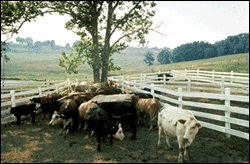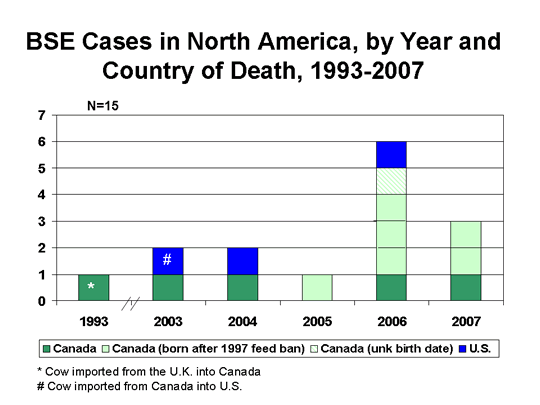About BSE
 |
 |
 |
Beef cattle grazing. (Image courtesy USDA) |
 |
BSE (bovine spongiform encephalopathy) is a progressive neurological disorder of cattle that results from infection by an unusual transmissible agent called a prion. The nature of the transmissible agent is not well understood. Currently, the most accepted theory is that the agent is a modified form of a normal protein known as prion protein. For reasons that are not yet understood, the normal prion protein changes into a pathogenic (harmful) form that then damages the central nervous system of cattle.
Research indicates that the first probable infections of BSE in cows occurred during the 1970's with two cases of BSE being identified in 1986. BSE possibly originated as a result of feeding cattle meat-and-bone meal that contained scrapie-infected sheep products. Scrapie is a prion disease of sheep. There is strong evidence and general agreement that the outbreak was then amplified and spread throughout the United Kingdom cattle industry by feeding rendered, prion-infected, bovine meat-and-bone meal to young calves.
The BSE epidemic in the United Kingdom peaked in January 1993 at almost 1,000 new cases per week. Through the end of 2007, more than 184,500 cases of BSE had been confirmed in the United Kingdom alone in more than 35,000 herds.
There exists strong epidemiologic and laboratory evidence for a causal association between a new human prion disease called variant Creutzfeldt-Jakob disease (vCJD) that was first reported from the United Kingdom in 1996 and the BSE outbreak in cattle. The interval between the most likely period for the initial extended exposure of the population to potentially BSE-contaminated food (1984-1986) and the onset of initial variant CJD cases (1994-1996) is consistent with known incubation periods for the human forms of prion disease.
Overview of BSE in North America

Click to enlarge
Through 2007, BSE surveillance has identified 15 cases in North America: three BSE cases in the United States and 12 in Canada. Of the three cases identified in the United States, one was born in Canada; of the 12 cases identified in Canada, one was imported from the United Kingdom (see figure above). Assuming that the proportions of animals sampled that were found to have BSE similarly reflect each country’s BSE prevalence, the surveillance data indicate that the prevalence of BSE in Canada is well over 20-fold higher than that in the United States (see BSE Prevalence below).
BSE Cases Identified in the U.S.
There have been 3 cases of BSE identified in the United States. The following information provides descriptions of these three cases:
- The first known case of BSE in the United States was identified in December 2003. On December 23, 2003, the U.S. Department of Agriculture (USDA) announced a presumptive diagnosis of BSE in an adult Holstein cow from Washington State. This diagnosis was confirmed by an international reference laboratory in Weybridge, England, on December 25. Preliminary trace-back based on an ear-tag identification number suggested that the BSE-infected cow was imported into the United States from Canada in August 2001. The preliminary trace-back identification of the animal was later confirmed by genetic testing.
- On June 24, 2005, the U.S. Department of Agriculture announced receipt of final results from The Veterinary Laboratories Agency in Weybridge, England, confirming BSE in a cow that had conflicting test results in 2004. This cow was from Texas and represented the first endemic case of BSE in the United States.
- On March 13, 2006, the U.S. Department of Agriculture (USDA) announced the confirmation of bovine spongiform encephalopathy (BSE) in a cow in Alabama. The newly confirmed case was identified in a non-ambulatory (downer) cow on a farm in Alabama. The animal was euthanized by a local veterinarian and buried on the farm. The age of the cow was estimated by examination of the dentition as 10-years-old. It had no ear tags or distinctive marks; the herd of origin could not be identified despite an intense investigation (see
 Alabama BSE Investigation, Final Epidemiology Report, May 2006 [PDF – 105 KB]). Alabama BSE Investigation, Final Epidemiology Report, May 2006 [PDF – 105 KB]).
For more information about BSE in the United States, see the Animal and Plant Health Inspection Service, USDA BSE site.
BSE Cases Identified in Canadian-born cattle
As of January 2008, 12 BSE cases in Canadian-born cattle have been identified, 11 in Canada and 1 in the United States. Six of these 12 BSE cases were known to have been born after the implementation of the 1997 Canadian feed ban; five of these six were born after March 1, 1999 (see item featured above on New Regulations). One of the 12 Canadian-born BSE cases was reported in an animal that was most likely born before or possibly very shortly after implementation of the 1997 feed ban. Based on the known or most likely year of birth, an average of just under 1 case of BSE occurred among the group of animals born each year in Canada from 1991 through 2003. The highest reported number of cases by birth year to date, 3 BSE cases, occurred among the group of animals born in Canada during the year 2000.
Strains of BSE
There is increasing evidence that there are different strains of BSE: the typical BSE strain responsible for the outbreak in the United Kingdom and two atypical strains (H and L strains).
Typical BSE strain -- The BSE strain responsible for most of the BSE cases in Canada is the same classic or typical strain linked to the outbreak in the United Kingdom. This typical strain has not yet been identified in any U.S.-born cattle.
Atypical BSE strain – In July 2007, the UK Spongiform Encephalopathy Advisory Committee (SEAC) suggested that atypical BSE may be a distinct strain of prion disease. Unlike typical BSE, cases of atypical BSE, according to SEAC, may have risen spontaneously (although transmission through feed or the environment cannot be ruled out). Recently reported French surveillance data support this theory that unlike classic BSE, atypical BSE appears to represent sporadic disease.
Both of the U.S.-born BSE cases and two of the twelve Canadian-born BSE cases were 10 years of age or older and all three of these older North American cases for whom the BSE strain is presently known were linked to an atypical BSE strain known as the H-strain. Strain testing on the 13 year-old BSE-infected Canadian cow identified in December 2007 is pending.
For statement from the UK Spongiform Encephalopathy Advisory Committee (SEAC): http://www.seac.gov.uk/statements/newforms-bse.htm
For additional data on this topic: http://www.cdc.gov/eid/content/14/2/298.htm
Feed Bans
As of July 12, 2007, an enhanced BSE-related feed ban came into effect in Canada. The Canadian Food Inspection Agency (CFIA) established this ban to more effectively prevent and quickly eliminate BSE from Canada. The enhanced ban prohibits most proteins, including potentially BSE infectious tissues known as “specified risk materials” (SRM) from all animal feeds, pet foods, and fertilizers, not just from cattle feed as required by the ban instituted in 1997. The 1997 feed ban in Canada was similar to the feed ban instituted in the United States that same year. As recently reported by CFIA, removing SRM from the entire animal feed system addresses risks associated with the potential contamination of cattle feed during production, distribution, storage, and use. Applying the same measure to pet food and fertilizer materials addresses the possible exposure of cattle and other susceptible animals to these products. CFIA expects that with this new ban, BSE should be eliminated from the Canadian cattle herd by about the year 2017.
In October 2005 in the United States, the Food and Drug Administration (FDA) published a proposed regulation to remove the highest risk cattle material from all animal feed. As of early February, this proposal remains under review. In addition, FDA continues to enforce its important 1997 mammalian-to-ruminant feed ban through its BSE inspection and BSE feed testing programs.
BSE Prevalence
In September 2007, The US Department of Agriculture published updated results of the two statistical models used by Harvard University investigators to estimate the prevalence of BSE in Canada. The updated results incorporated the 11 Canadian-born animals with BSE that had been reported by that time. A key advantage of these models is that they provide statistical confidence limits that measure some of the uncertainty associated with expected estimates. To view the results of the model, called BSurvE , that is most comparable to the observed surveillance data see ( page 15 [PDF – 261 KB]). This model estimates that the true prevalence of BSE in Canada is 90% likely to be between 18-fold and 48-fold higher than the previously published best estimate of the prevalence of BSE in the United States. The previously published best estimate of Canada’s BSE prevalence in 2006 using the BSurveE model was 23-fold higher than that of the United States and is the estimate of the BSE prevalence in Canada that continues to be used in the Harvard Risk Assessments’ “worst case” analyses when evaluating the risk of imported Canadian cattle causing BSE to spread among US animals. page 15 [PDF – 261 KB]). This model estimates that the true prevalence of BSE in Canada is 90% likely to be between 18-fold and 48-fold higher than the previously published best estimate of the prevalence of BSE in the United States. The previously published best estimate of Canada’s BSE prevalence in 2006 using the BSurveE model was 23-fold higher than that of the United States and is the estimate of the BSE prevalence in Canada that continues to be used in the Harvard Risk Assessments’ “worst case” analyses when evaluating the risk of imported Canadian cattle causing BSE to spread among US animals.
For more information on this topic:
 An Estimate of the Prevalence of BSE in the United States, July 20, 2006 (PDF – 259 KB) An Estimate of the Prevalence of BSE in the United States, July 20, 2006 (PDF – 259 KB) APHIS, USDA, Assessment of Bovine Spongiform Encephalopathy risks associated with the importation of certain commodities from BSE minimal risk regions (Canada), Attachment 1, October 27, 2006 (PDF – 279 KB) APHIS, USDA, Assessment of Bovine Spongiform Encephalopathy risks associated with the importation of certain commodities from BSE minimal risk regions (Canada), Attachment 1, October 27, 2006 (PDF – 279 KB) APHIS, USDA’s BSE Surveillance Efforts Factsheet, July 2006 (PDF – 56 KB) APHIS, USDA’s BSE Surveillance Efforts Factsheet, July 2006 (PDF – 56 KB)
For regularly updated numbers of reported BSE cases worldwide, see the Office International Des Epizooties (OIE) BSE website.
For information about BSE in Canada, see the Canada Food Inspection Agency (CFIA) website.
 Topic Contents: Topic Contents:
 See Also: See Also:
 Please note: Some of these publications are available for download only as *.pdf files. These files require Adobe Acrobat Reader in order to be viewed. Please review the information on downloading and using Acrobat Reader software. Please note: Some of these publications are available for download only as *.pdf files. These files require Adobe Acrobat Reader in order to be viewed. Please review the information on downloading and using Acrobat Reader software.
* Links to non-Federal organizations found at this site are provided solely as a service to our users. These links do not constitute an endorsement of these organizations or their programs by CDC or the Federal Government, and none should be inferred. CDC is not responsible for the content of the individual organization Web pages found at these links.
|